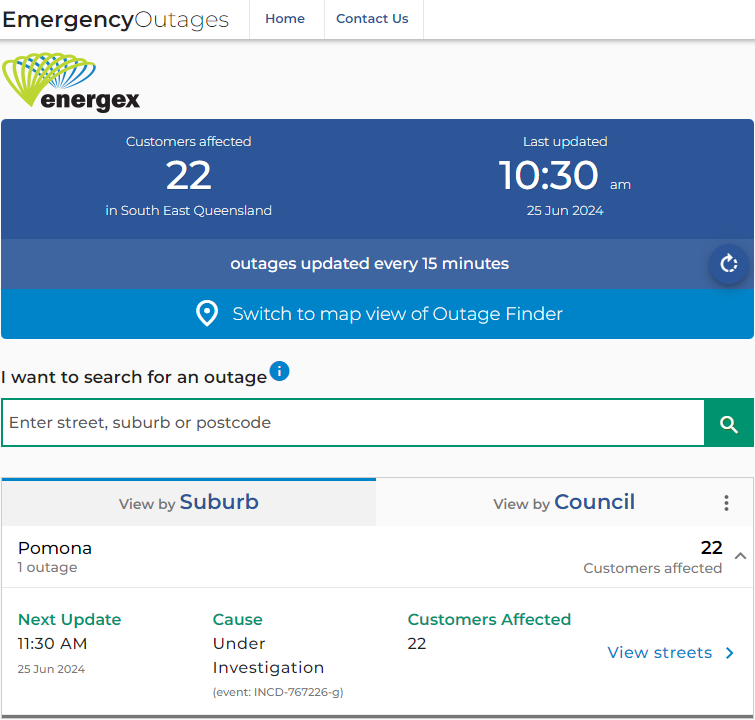KEY POINTS
- A power outage is when the supply of electricity to a household is interrupted.
- A power outage could be unplanned or planned. The former is caused by unforeseen events such as a storm and the latter is scheduled by energy distributors to conduct upgrades or maintenance work.
- Check for power outages by searching on the website of your local energy distributor.
On this page:
What is a power outage?
A power outage occurs when the supply of electricity or gas to a household or business is interrupted.
Power outages that impact entire neighborhoods or cities are referred to as blackouts and can occur at any time.
What causes power outages?
A power outage can occur for planned or unplanned reasons:
Planned outages
Planned outages are scheduled by energy companies for maintenance or upgrades. Distribution networks require constant upkeep to ensure that electricity and gas lines run efficiently and safely to homes and businesses.
Unplanned outages:
Unexpected power outages occur due to unforeseen events such as:
- Weather: Heavy rainfall, heatwaves, high winds, lightning strikes, and bushfires can damage electrical lines, generators or substations.
- Trees: Blackouts can also occur when overhanging branches or trees come into contact with power lines.
- Road accidents. A car colliding with a utility pole or power line can trigger a power outage.
- Animals: Wildlife can interfere with energy infrastructure.
- Vandalism: Power lines, substations or electrical grids could be deliberately damaged.
- Unpaid Bills: If you constantly fail to pay your power bills, your energy provider may forcefully disconnect your home from the grid.
- Faulty appliances: A malfunctioning appliance can cause your switchboard to trip, triggering a power outage limited to your home.
- Power surge: Power outages can be caused by overloading when high-voltage appliances or rapid demand strain electrical systems (i.e. power grids and circuit boards).
How long do power outages last?
Depending on the severity of the power outage, loss of power can last from minutes to weeks, and will usually affect specific areas or electricity grids.
A resolution will be estimated by the energy distribution network where the power outage occurred. Time estimates will depend on the root cause of the outage.
Extreme weather can impact Australia’s energy infrastructure, resulting in damaged electricity grids and long-lasting power outages.
In those instances, it is extremely difficult to assess how long a power outage will last.
Preparing for a power outage
It pays to be prepared. You can be prepared for power outages throughout the year by following these Canstar Blue tips.
Be wary of storm seasons
According to the Bureau of Meteorology, the Australian cyclone season runs from November to April every year.
Ensure your emergency kit is up to date
Curate an emergency kit including the following essentials:
- Cash
- Candles
- Blankets
- Batteries
- First aid kit
- LED torch
- Fire blanket
- Fire extinguisher
- Matches or a lighter
- Generator (if possible)
- Battery-operated radio
- List of important contacts
- Portable phone charger and cords
- Bottled water and non-perishable foods
- List of emergency numbers (your state emergency service, energy distributor and electricity provider)
- Medication (if you have a pre-existing medical condition).
Make sure everyone in your household knows where the emergency kit is kept so they’re able to grab it when necessary.
Frequently maintain your yard
Before storm season approaches, regularly pruning trees will help prevent branches falling on power lines, reducing the likelihood of a power outage.
Securing or storing items that could sway in high winds isn’t essential, but it is a good way of minimising risk to your own and others’ safety and damage to your home.
Fireproof your appliances
If you don’t already have a surge protector, consider purchasing one to avoid damage to your equipment and lower the risk of electrical fires caused by a power surge.
Plan for emergency power
In the event of a power outage, your home may require essential and critical appliances to run uninterrupted. This is especially true for life-sustaining equipment. You’ll need to find another source of power.
Consider purchasing a home generator. Alternatively, you can choose to install rooftop solar and a solar battery with partial or full backup functionality (depending on your needs).
The setup is fairly simple: a cable is run from the battery and solar inverter to a select number of circuits in the switchboard. This divides your home into three circuits:
- Critical loads: Appliances such as life-sustaining equipment that must remain operational and cannot be turned off.
- Essential loads: Your fridge and lights may be put in the essential category.
- Non-essential: Creature comforts such as a coffee machine or gaming system might not be deemed essential and excluded.
If your power does fail, your battery should detect an outage and switch to blackout mode — as long as there’s enough energy stored.
Have a backup plan for life-sustaining equipment
If you have life-sustaining equipment, make sure your electricity provider is aware of your need to keep it running so your home is prioritised for reinstatement once the power returns.
It may also be a good idea to let your healthcare provider know about your backup plan in case they can offer further assistance.
What to do when the power goes out
During an unexpected power outage, the best thing to do is to remain calm and follow the steps below:
Safely determine the cause of the outage:
- Have your home’s safety switch or switches been tripped?
- Have you missed a message from your provider about a planned outage?
- Was it caused by the weather?
After isolating the cause of the outage, take the appropriate steps to ensure everyone in your home remains safe. What that will look like will depend on what triggered the outage.
If the power outage was caused by the weather
If the power outage was triggered by inclement weather, we recommend trying the following:
- Call your energy provider or check their website or social media for blackout updates. You can use a portable radio or phone to listen for updates.
- Unplug any unnecessary electrical equipment.
- If the weather permits, check for fallen powerlines in your neighborhood. If there is a damaged powerline, keep a safe distance and alert your energy distributor. In case of life-threatening emergencies, call 000.
- Avoid opening the fridge door to avoid the loss of cold air, slowing down how fast your food spoils.
- Turn on your smartphone’s power-saving mode to conserve battery.
If the power outage was planned
If it’s a planned outage, there probably isn’t much else to do but wait for it to be over.
Planned power outages will normally be listed on your energy distributor’s website.
Depending on your distributor, the following information should be provided:
- Outage start date and time
- Suburbs or postcodes impacted by power outage
- Number of customers affected
- Scheduled completion date and time
- ID or job number
- Status (i.e. scheduled, in progress or finished)
If the power outage was caused by a switch tripping
If a switch or multiple switches have tripped on your home’s switchboard, that means power to that circuit has been severed from an electrical fault or an overload (power surge).
To diagnose the problem, try following the steps below:
- Try turning the tripped switch to the ‘ON’ position.
- If it flips back to ‘OFF’ instantly, unplug or turn off all your plugged appliances.
- Turn the tripped switch to the ‘ON’ position again.
- If it remains in ‘ON’, start plugging in each appliance and turning them on.
- During this process, you’ll likely identify the appliance that triggers the tripping.
- Stop using the faulty appliance.
- If you fail to isolate the faulty appliance, contact a licensed electrician to assess the underlying problem.
What to do after a power outage
Once power has returned to your home, make sure you do the following:
- Inspect your home, looking out for any risks or hazards caused by the outage. Do not conduct repairs by yourself. Contact your distributor or an electrician.
- Plug all your appliances and equipment back in and turn them on to ensure they’re working (as long as you have no reason to believe they’ve been damaged by a power surge).
- Use a thermometer to assess whether your refrigerated and frozen food is spoiled.
How to find power outages in your area
Your energy distributor should have a power outage map on its website where you can input your street, suburb or postcode and receive updates of reported power outages.
The example below comes from Energex, the electricity distributor for South East Queensland.

Image source: energex.com.au
How to find current power outages in QLD
To find current power outages in QLD, visit your provider’s website listed below, or call their faults contact number.
Electricity distributors
← Mobile/tablet users, scroll sideways to view full table →
| Location | Electricity distributor | Faults contact number |
|---|---|---|
| Brisbane, Gold Coast, Sunshine Coast and surrounds |
Energex | 136 262 |
| Country and regional Qld | Ergon Energy | 132 296 |
How to find current power outages in NSW
To find current power outages in NSW, visit your provider’s website listed below, or call their faults contact number.
Electricity distributors
← Mobile/tablet users, scroll sideways to view full table →
| Location | Electricity distributor | Faults contact number |
|---|---|---|
| Sydney’s Greater West, the Blue Mountains, Southern Highlands, Illawarra and South Coast |
Endeavour Energy | 131 003 |
| Country and regional NSW and southern regional QLD |
Essential Energy | 132 080 |
| Sydney, the Central Coast and Hunter Valley | Ausgrid | 131 388 |
How to find current power outages in Vic
To find current power outages in Vic, visit your provider’s website listed below, or call their faults contact number.
Electricity distributors
← Mobile/tablet users, scroll sideways to view full table →
| Location | Electricity distributor | Faults contact number |
|---|---|---|
| Melbourne City and inner suburbs | CitiPower | 131 280 |
| Northern and southwestern suburbs | Jemena | 131 626 |
| Western suburbs, CBD and inner suburbs of Melbourne and central and western Victoria |
Powercor Australia | 132 412 |
| East and northeast Victoria and north and east Melbourne |
AusNet Services | 131 799 |
| East and southeast Melbourne and the Mornington Peninsula |
United Energy Distribution | 132 099 |
How to find current power outages in WA
To find current power outages in WA, visit your provider’s website listed below, or call their faults contact number.
Electricity distributors
← Mobile/tablet users, scroll sideways to view full table →
| Location | Electricity distributor | Faults contact number |
|---|---|---|
| South West Interconnected System | Western Power | 131 351 |
| Rural Western Australia | Horizon Power | 132 351 |
How to find current power outages in SA
To find current power outages in SA, visit your provider’s website listed below, or call their faults contact number.
Electricity distributors
← Mobile/tablet users, scroll sideways to view full table →
| Location | Electricity distributor | Faults contact number |
|---|---|---|
| All of SA | SA Power Networks | 131 366 |
How to find current power outages in NT
To find current power outages in NT, visit your provider’s website listed below, or call their faults contact number.
Electricity distributors
← Mobile/tablet users, scroll sideways to view full table →
| Location | Electricity distributor | Faults contact number |
|---|---|---|
| All of NT | Power and Water Corporation | 1800 245 090 |
How to find current power outages in the ACT
To find current power outages in the ACT, visit your provider’s website listed below, or call their faults contact number.
Electricity distributors
← Mobile/tablet users, scroll sideways to view full table →
| Location | Electricity distributor | Faults contact number |
|---|---|---|
| Most of the ACT | EvoEnergy | 131 093 |
| A small portion of the ACT and Queanbeyan area |
Essential Energy | 132 080 |
How to find current power outages in Tas
To find current power outages in Tas, visit your provider’s website listed below, or call their faults contact number.
Electricity distributors
← Mobile/tablet users, scroll sideways to view full table →
| Location | Electricity distributor | Faults contact number |
|---|---|---|
| All of Tasmania | TasNetworks | 132 004 |
Compare energy plans
If you want to switch energy providers or compare current plans, check out the Canstar Blue comparison tool below.
Here are some of the cheapest published deals from the retailers on our database that include a link to the retailer’s website for further details. These are products from referral partners†. These costs are based on the Ausgrid network in Sydney but prices may vary depending on your circumstances. This comparison assumes general energy usage of 3900kWh/year for a residential customer on a single rate tariff. Please use our comparison tool for a specific comparison in your area. Our database may not cover all deals in your area. As always, check all details of any plan directly with the retailer before making a purchase decision.
Here are some of the cheapest published deals from the retailers on our database that include a link to the retailer’s website for further details. These are products from referral partners†. These costs are based on the Citipower network in Melbourne but prices may vary depending on your circumstances. This comparison assumes general energy usage of 4000kWh/year for a residential customer on a single rate tariff. Please use our comparison tool for a specific comparison in your area. Our database may not cover all deals in your area. As always, check all details of any plan directly with the retailer before making a purchase decision.
Here are some of the cheapest published deals from the retailers on our database that include a link to the retailer’s website for further details. These are products from referral partners†. These costs are based on the Energex network in Brisbane but prices may vary depending on your circumstances. This comparison assumes general energy usage of 4600kWh/year for a residential customer on a single rate tariff. Please use our comparison tool for a specific comparison in your area. Our database may not cover all deals in your area. As always, check all details of any plan directly with the retailer before making a purchase decision.
Here are some of the cheapest published deals from the retailers on our database that include a link to the retailer’s website for further details. These are products from referral partners†. These costs are based on the SA Power network in Adelaide but prices may vary depending on your circumstances. This comparison assumes general energy usage of 4000kWh/year for a residential customer on a single rate tariff. Please use our comparison tool for a specific comparison in your area. Our database may not cover all deals in your area. As always, check all details of any plan directly with the retailer before making a purchase decision.



Share this article